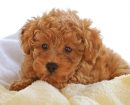Content |
|---|
History
The Poodle is a breed of dog, from the fifteenth century to the present day, It is considered to be of exclusive use for the luxury of the aristocrats and nobles. Known for its woolly and curly coat, There are four varieties: Grand, Medium-, Dwarf and Toy.
Until the Renaissance, This was a collector of water dog, they retrieved the already hunted prey that had fallen into the water, such as ducks and swans.
In each language, the poodle Gets a different name:
- English: Poodle, French Poodle
- French: Caniche, Chien Canard
- German: Pudel
- Italian: Barbone Nano, Barboncino
- Spanish: Caniche
From France, the Poodle is a descendant of Barbet, original German swamp; and in the middle ages, He was assigned to tumble as duck or goose birds hunting, so it was selected for characteristics such as its adaptability to boggy terrain and its resistance to water, What makes this breed, along with others are called water dogs.
From the 16th century, the poodles began to be famous for her beauty and intelligence, especially in various circus performances and works of art by various authors as Albrecht Dürer and Francisco de Goya. In the times of Louis XVI of France, their presence in the French court was already very common..
By changes in taste in its appearance, during the 19th century the protection of the fur that was scorned, until then, had the function of protecting him from hypothermia, What stylists began to create various courts such as the British Montano and the Continental. For the poodle newborns, began the custom of amputate the tail.
The Franco-Prussian War began the dissemination of the race as such, intended for millionaires and aristocrats. In the 20th century, only dominated the giant variety, Therefore, later, with the approval of the Canine Associations —such as the Kennel Club— the Standard varieties emerged. (low diffusion from 1792), Miniature (1911) and Toy (1957). In the final years of the 20th century, the hybrid race emerged “Labrapoodles” (combination of Poodleand with Labrador).
Did you know??
These canines curly hair are often considered the national dog of France, although the breed originated in Germany.
Physical characteristics
The four varieties of Poodle:
Poodle large:
Is believed to be the original variety of which emerged the other varieties, through crossings to reduce the size. The height at the withers varies from 45 to 60 cm., is supported 2 cm over, provided that the copy keep proportions. Y, they weigh around 30 kg.
This type of poodle is perhaps, the less well known, and at the same time the more quiet. Measures of 36 to 44 Cross cm, and as in all sizes, just accept the plain colors in fur. The weight is commensurate with its size.
This variety has a height to the cross 28 to 35 cm.. You have to look like a medium-sized Caniche, but smaller and show no signs of dwarfism. As in the larger varieties, they are judged grouped by colors.
The variety has a height of between 24 and 28 centimeters at the withers or height, provided that the proportions are maintained and that they do not present any symptoms of dwarfism. Are judged all together colors.
Depending on your health, a miniature poodle lives on average 14,8 years; one Toy 14,4 years; a medium Poodle also 14,4 years, and a Large Poodle live media 13,5 years. Although these data are quite accurate, It is not uncommon to see poodle small, of more than 18 years, or even of 20.
In the exhibitions held under the rules of the FCI, copies of black, White and Brown are judged in the same group to obtain the CACIB. The same applies to copies of grey, Apricot and Red; the best of each of these groups becomes a final judgment to determine the best copy of the variety.
For your care, Peel according to your style, requiring a dog hairdresser. Accepted the hair in the form of long-haired head, ears and neck, including legs. They do not loose too much hair and health must clean the eyes and ears. They should be washed with some frequency. The care of the fur is unconditional in this breed, so it is necessary to wash with exclusive dog shampoo and in no case with human shampoo, that damages the skin of the Caniche because it causes you to lose the natural oil that has in its hair and, in the long run, brings complications.
Their care has to be very guarded, because due to his long-haired Kale, thick and woolly, of a single type of hair, It can tangle with ease. They require cepillados every week (without going).
The baths should be monthly (It is not advisable or necessary to abuse these) with moisturizing shampoos and masks. It has to be dried with a dryer and never air. They are dogs that after the silent main hair puppy to adult not move almost hair and are nearly hypoallergenic.
There are many types of court, but students admitted for exhibition: Continental, Continental American, Scandinavian and Puppy Clip. The Court will be based on the structure of the dog and the taste of exhibitor or owner, the most widely used is the American Continental.
Apart from the common poodle, There is also the variety Cordelé, taking this more curly hair and being able to display in the form of strings as the Puli.
Health Poodles
Not all of these diseases affect standard poodles, but the conditions that can generally occur in poodles include the following:
Addison's disease and Cushing's syndrome are two sides of the same coin. In dogs with Addison's disease, the adrenal glands produce insufficient amount of the hormone cortisol. Dogs become lethargic, intolerant and depressed stress, and may have digestive problems. Some dogs may have an acute crisis, requiring hospitalization. The lifelong treatment involves the administration of drugs.
In dogs with Cushing's syndrome, the adrenal glands produce too much cortisol. Symptoms include weight gain, gasps, excessive thirst and hunger, bladder infections and urinating in the house but the dog has been previously trained. Cushing's disease is usually controlled with medication for life, but sometimes surgery is necessary.
Another hormonal problem seen in poodles is hypothyroidism (An inappropriate thyroid hormone). Symptoms include weight gain, loss of hair, lack of resistance to disease, excessive hunger and heat seeking. Normally supplements prescribed thyroid hormone to control the condition.
Progressive retinal atrophy (ARP) is an eye disease that can eventually lead hereditary blindness. Standard other potential eye problems in poodles and toy are cataracts and glaucoma. Poodles can also be affected by von Willebrand's disease (a disorder of blood clotting).
Although all Poodles, regardless of size, They are the same “race”, They not all have the same health problems. Poodles toy and miniature poodles share many common health problems for smaller breeds of dogs, as kneecaps that easily out of place (You dislocated kneecaps), breathing difficulties caused by a collapse of the trachea and dental problems due to the overcrowding of teeth within their small mouths.
The Toy Poodles can also suffer Legg-Calvé-Perthes disease, which causes a reduction of the blood supply to the head of the bone of the thigh, causing degradation. The first sign of this disease is lameness, that usually appears when the puppy has to 4 to 6 months of age. Treatment is surgical, after which the puppy can lead a relatively normal life apart from a greater chance of developing arthritis.
Standard Poodles, like many large breeds deep chest, They have an increased risk of swelling, also known as gastric dilation volvulus, a life-threatening condition in which the stomach twists on itself, trapping air inside. Swell dogs require immediate veterinary care and, usually, surgery to correct the problem. Since most dogs that swell once swell again, the surgeon may also recommend a procedure known as “turn of the stomach” or gastropexia, as a preventive measure.
A skin problem that can affect the toy poodles and standard is the sebaceous adenitis, an inflammation of the sebaceous glands that causes hair loss and skin problems. It can be diagnosed with a skin biopsy, but the effectiveness of treatment varies.
Hip dysplasia is an orthopedic problem beginning at puppyhood. Is a malformation and poor fit of the joint of the ball and socket hip. It may be a minor problem or life-altering disability. Treatment can range from something as simple as daily medication to major surgery., even a hip replacement.
Last, Standard Poodles have a higher incidence of certain cancers, including insulinoma and hemangiosarcoma, compared to some other breeds.
Not all of these conditions are detectable on a growing puppy, and it can be difficult to predict whether an animal will be free of these diseases, so it is necessary to find a reputable breeder who commit to raise healthier animals possible. Must be able to produce an independent certification that the parents of the dog (and grandparents, etc.) have been screened for these defects and considered healthy for breeding. That's where health records come in..
Careful breeders screen their breeding dogs for genetic diseases and breed only the healthiest and best looking dogs, but sometimes Mother Nature has other ideas and a puppy develops one of these diseases despite good husbandry practices. Advances in veterinary medicine mean that in most cases dogs can still live a good life.
Character and skills
Intelligent, loving, legal and naughty, those are the four words that the poodle enthusiasts describe the personality and character of this breed.
Despite his actual appearance, the poodle has a playful side, likes to interact with their owners, tends to be very friendly with people and always likes to please.
If we combine his legendary intelligence with its sociability gives as a result a dog highly entrenable.
A poodle, you have been taught canine manners, will have a quiet character, especially if you exercise regularly to burn off your natural energy.
The poodle is a protective dog that will not hesitate to use its bark when a stranger approaches its home., and although he is affectionate with the family, can take you some time socializing with other people.
An outstanding feature of the poodle is their intelligence (occupies the position No. 2 on classification of intelligence dog breeds by Stanley Coren).
It is often said that they have a human intelligence, an incredible cunning that amazes its owners. Of course, smart dogs can be tricky. They learn fast, both the bad and good habits
Basics of grooming poodles
The toilet is an important consideration in Poodles. Fine and curly coat that worked well when the Poodle spent his time in the water needs to be trimmed regularly, normally every 6 u 8 weeks, depending on the preferences of its owner. It easily fits and requires regular brushing at home, even with a professional grooming. If left untrimmed, coat will curl naturally strings, although some people prefer that aspect.
Dental care is important, particularly for Poodles Toys and Miniatures. Keep the much brushing her teeth with toothpaste approved by the vet pet and making a veterinarian make regular dental checkups.
Trim nails as needed, usually every week or two. They should not be so long that you can hear the click on the ground.
Characteristics "Poodle"
Coexistence is important that you have with your new friend. Before considering the acquisition of a dog of the breed "Poodle" you know certain factors. Not all breeds of dogs are apt to live in an apartment, you must take into account his character, their need for exercise, their interaction with other pets, their care and if you have small children, their level of tolerance towards them.
Adaptation ⓘ5.0 out of 5 stars (based on 1 review)
|
friendly dog ⓘ4.0 out of 5 stars (based on 1 review)
|
hair loss ⓘ1.0 out of 5 stars (based on 1 review)
|
|---|---|---|
Affection level ⓘ5.0 out of 5 stars (based on 1 review)
|
Need for exercise ⓘ4.0 out of 5 stars (based on 1 review)
|
Social need ⓘ5.0 out of 5 stars (based on 1 review)
|
Home ⓘ5.0 out of 5 stars (based on 1 review)
|
Toilet ⓘ5.0 out of 5 stars (based on 1 review)
|
Friendly with strangers ⓘ4.0 out of 5 stars (based on 1 review)
|
barking ⓘ3.0 out of 5 stars (based on 1 review)
|
Health ⓘ3.0 out of 5 stars (based on 1 review)
|
Territorial ⓘ4.0 out of 5 stars (based on 1 review)
|
Cat friendly ⓘ4.0 out of 5 stars (based on 1 review)
|
Intelligence ⓘ5.0 out of 5 stars (based on 1 review)
|
Versatility ⓘ5.0 out of 5 stars (based on 1 review)
|
Child friendly ⓘ5.0 out of 5 stars (based on 1 review)
|
Surveillance ⓘ4.0 out of 5 stars (based on 1 review)
|
joy ⓘ4.0 out of 5 stars (based on 1 review)
|
Breeders of the breed "Poodle"
Poodle images
Poodle Videos
Type and recognitions:
- FCI CLASSIFICATION: 172
- Group 9: Companion and Toy Dogs
- Section 2: Poodle. Without working trial..
Federations:
- FCI – Group 9 Section 2 “Poodle” ⓘ
- AKC – Toy Group ⓘ
- ANKC – Toy Group 7 (Non-Sporting) ⓘ
- KC – Toy Utility ⓘ
- CKC – Group 5 – Toys ⓘ
- NZKC – Non-sporting toy ⓘ
- UKC – Company ⓘ
FCI breed standard "Poodle"
Alternative names:
1. Pudelhund, Caniche (English).
2. Caniche (French).
3. Caniche (German).
4. Caniche (Portuguese).
5. Poodle (español).

















 Dogs 101 – Pudelhund
Dogs 101 – Pudelhund Miniature Poodle Tricks
Miniature Poodle Tricks Standard Poodle
Standard Poodle Poodle Teddy Bear Clip / Pet Grooming Studio Academy
Poodle Teddy Bear Clip / Pet Grooming Studio Academy
It is a very intelligent dog.
I have 61 years and a bone metastasis, I would like to know if the character of this dog could be the right one for me, short walks, due to my medical condition, I would like a female, not necessarily puppy, tender, little talkative ( bad for small dogs), and to let them pamper muuucho. Thank you